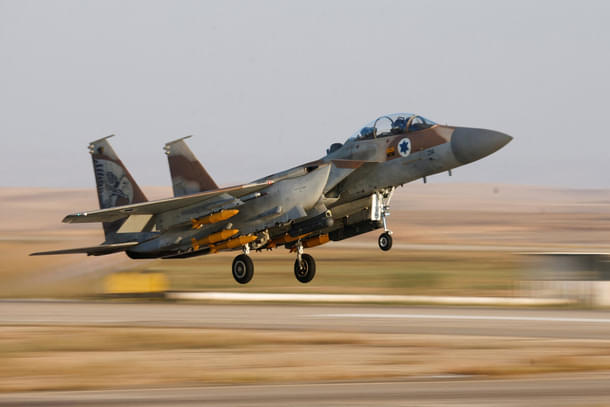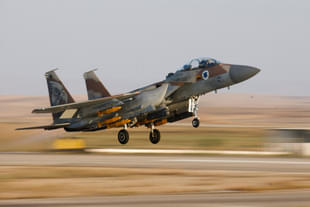World
Killing Nasrallah: How Israel Pulled Off The Ultimate Hit On Hezbollah
Swarajya Staff
Sep 30, 2024, 03:30 PM | Updated Oct 04, 2024, 06:24 PM IST
Save & read from anywhere!
Bookmark stories for easy access on any device or the Swarajya app.


In the heart of the southern suburbs of Beirut, a clandestine meeting buzzed with urgency at Hezbollah’s central headquarters. The key players were present, including Hassan Nasrallah, plotting their next moves against Israel, which was ramping up its relentless campaign to dismantle Hezbollah's missile caches hidden within homes and depots throughout southern Lebanon.
What they didn’t know was that Israeli intelligence had been eavesdropping, intercepting vital details about their gathering just hours before it kicked off.
Seizing this golden opportunity, Israeli military officials sprang into action, launching an audacious strike plan.
Eight fighter jets were assigned the task, each loaded with 2,000-pound precision-guided bombs, including powerful BLU-109 bunker busters — munitions engineered specifically to penetrate even the toughest underground fortifications. Ironically, earlier this year, the Joe Biden administration in the US had put the brakes on shipments of these bombs to Israel, citing concerns over civilian casualties in Gaza.
Within moments, the planes were above their target, and chaos erupted as the sky lit up with a series of thunderous explosions. In a stunning display of firepower, over 80 tonnes of bunker busters rained down in rapid succession, each blast meticulously timed to unleash a cataclysmic chain reaction of destruction.
The strategy was simple yet effective: each blast aimed to clear the way for the next, breaking through the reinforced shelter where Nasrallah was present.
And just like that, Israel scored a monumental victory. Nasrallah — one of Israel’s most formidable enemies outside Iran — was dead.
This strike was more than just a win; it validated Israel's massive investment in intelligence to overcome the blunders of its previous incursion into Lebanon in 2006.
Back then, the Israeli air force had run out of pre-approved targets within the first week, leaving its pilots to flounder for the remaining 34 days of conflict. They flew some of the most advanced warplanes on the planet but could only strike Hezbollah positions revealed during the fighting instead of hitting the strategic sites that years of intelligence work should have exposed.
The previous war ended in a frustrating stalemate, with Israel — an advanced military power — struggling against Hezbollah, the Iran-backed group that had only grown stronger over the last 18 years. It was a bitter blow for Israel, which had once enjoyed a reputation as a dominant fighting force, having thwarted numerous Arab attempts to wipe it off the map.
The killing of Nasrallah on 27 September was a crowning achievement, coming just a week after the deadly detonation of thousands of booby-trapped Hezbollah pagers and hundreds of radios. This assassination marked the climax of a swift series of strikes that had decimated half of Hezbollah's leadership and severely crippled its military command.
One by one, Israel had expertly targeted and obliterated the caches of missiles and weapons Hezbollah had painstakingly gathered and concealed over the years.
This triumph was a direct result of Israel's strategic decision to pour resources into intelligence gathering focused on Hezbollah after the 2006 debacle. It marked a turning point for Israeli intelligence, which had been sharpening its focus on Hezbollah for nearly two decades.
In the years that followed, Israel fortified what was already one of the world’s premier intelligence operations. Much of this effort was channelled into the Mossad and military intelligence, both of which had been left frustrated by their failures in gathering critical information on Hezbollah’s leadership and strategies leading up to the 2006 war.
In response, Unit 8200, Israel's elite signals intelligence agency, rolled out cutting-edge cyber tools to intercept Hezbollah’s communications while assembling new teams within the military to ensure that crucial intelligence flowed seamlessly to soldiers and air force units.
Israel also significantly ramped up its deployment of drones and high-tech satellites over Lebanon, meticulously monitoring Hezbollah strongholds and documenting even the tiniest changes in buildings that could signal a weapons depot. One former intelligence officer called this effort "Sisyphean", yet in the past week, the Israeli air force had relentlessly hammered many of these sites.
Taking advantage of Lebanon’s proximity — just under 150 miles from Jerusalem — Israel inserted undercover commandos deep within the country to carry out high-stakes intelligence operations.
The pivotal moment came in 2012 when Israel spotted a crack in Hezbollah’s defences. The militant group had redirected its fighters to Syria, aiding Bashar Al-Assad in suppressing a brutal uprising. This move was a treasure trove for Israeli intelligence, as Hezbollah began inadvertently sharing details about its fallen fighters, exposing personal information that should have remained hidden.
As Hezbollah became mired in the Syrian chaos, its once-disciplined ranks began to fray. The group grew more inclusive, admitting recruits who didn’t meet their usual standards. This shift allowed Israel to gather invaluable insights, crafting detailed profiles of Hezbollah operatives, even tracking those attending the funerals of slain fighters.
With this newfound intelligence, Israeli spies launched a covert offensive to infiltrate Hezbollah’s communication networks. They tracked operatives’ movements, sometimes even tapping into their wives’ cell phones for intel. The audacity escalated to hacking into surveillance cameras across Lebanon and monitoring the mileage on Hezbollah leaders' vehicles.
This painstaking surveillance bore fruit. Israeli officials learned to identify patterns, recognising that any deviation from the norm signalled impending trouble.
That intel proved crucial when Israeli forces struck again in Beirut, catching Nasrallah just as he made his way to his command bunker. In a flash, what was meant to be a secure meeting turned into a dramatic and deadly blow to Hezbollah’s leadership.





